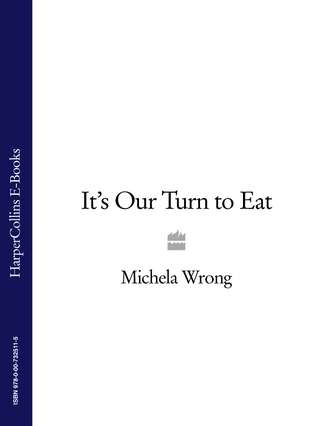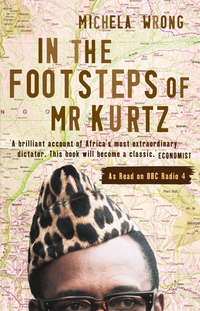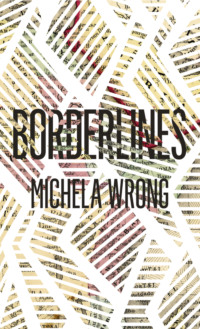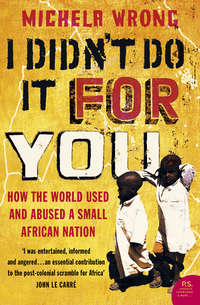
Полная версия
It’s Our Turn to Eat
When they speak in this way, Kenyans show, at least, a refreshing honesty. Public discourse is far more hypocritical. In matters ethnic, newspaper and radio station bosses adopt a policy of strict self-censorship. Telling themselves they must play their part in the forging of a young nation state, editors have for decades carefully removed all ethnic identifiers from articles and broadcasts. But it doesn't take long to work out what is really going on, or why one VIP is throwing the taunt of ‘tribalist’ – Kenya's favourite political insult – in another's face. If a surname isn't enough to accurately ‘place’ a Kenyan, laborious verbal codes do the trick. A commentator who coyly refers to ‘a certain community’, or the ‘people of the slopes’, means the Kikuyu and their kinsfolk from the Mount Kenya foothills. ‘People of the milk’ indicates the livestock-rearing Kalenjin or Maasai. If he cites ‘the people of the lake’ or ‘those from the west’, he means the Luo, whose territory runs alongside Lake Victoria and whose failure to practise circumcision – gateway to adulthood amongst Bantu communities – prompts widespread distrust. The sly euphemisms somehow end up conveying more mutual hostility than a franker vocabulary ever could. Like the ruffled skirts which covered the legs of grand pianos in the Victorian age, they actually draw attention to what they are supposed to conceal: an acute sensitivity to ethnic origin.
The fixation shocks other Africans, who privately whisper at how ‘backward’ they find Kenya, with its talk of foreskins and its focus on male appendages. ‘There's no ideological debate here,’ complain incoming diplomats, baffled by a political system in which notions of ‘left’ or ‘right’, ‘capitalist’ or ‘socialist’, ‘radical’ or ‘conservative’ seem irrelevant: ‘It's all about tribe.’ Directors of foreign NGOs puzzle over the fact that political parties, born and dying with the speed of dragonflies, either don't bother publishing manifestos, or barely know their contents. But who needs a manifesto when a party's only purpose is furthering its tribe's interests? Tribe is the first thing Kenyans need to know about one another, the backdrop against which all subsequent interaction can be interpreted, simultaneously haven, shield and crippling obligation. The obsession is so pervasive, Kenyans struggle to grasp that it may not extend beyond the country's borders. ‘So,’ commented a Kikuyu taxi driver when he overheard me expressing scepticism about the likelihood of an Obama win in the 2008 US election, ‘I see you Westerners have problems with the Luo too.’
Yet, perversely, the strength of these stereotypes is in inverse proportion to their longevity. Rooted in the country's experience as a British colony, Kenya's acute ethnic self-awareness, far from being an expression of ‘atavistic tribal tensions’, is actually a fairly recent development. While no one would claim that colonialism created the country's tribal distinctions, it certainly ensured that ethnic affiliation became the key criterion determining a citizen's life chances.
Some time towards the end of the nineteenth century, the story goes, a great Kikuyu medicine man, Mugo Wa Kibiru, woke up trembling, bruised and unable to speak. When he recovered his voice, he issued a terrible prophecy. There would come a time of great hunger, he said, after which strangers resembling little white frogs, wearing clothes that looked like butterfly wings, would arrive bearing magic sticks that killed as no poisoned arrow could. They would bring a giant iron centipede, breathing fire, which would stretch from the big water in the east to the big water in the west, and they would be intent on stripping his people of all they possessed. His people should not fight these strangers. They must treat them with caution and courtesy, the better to learn their ways. The strangers would only depart once they had passed on the secrets of their power.
His prophecy was an uncannily accurate description of the railway that would eventually stretch more than a thousand kilometres from Mombasa on the coast to Kisumu on Lake Victoria. It would never have existed had it not been for William Mackinnon, a Scottish magnate with an evangelical agenda and a romantic appetite for empire, whose imagination was fired by reports brought back by Livingstone and Stanley. The lush kingdom of Buganda, nestling on the shores of Africa's giant freshwater lake in what is today southern Uganda, was blessed with gum, ivory, copra, cotton and coffee. Opening up the hinterland would not only allow its riches to be tapped, it would also, Mackinnon maintained, mean the eradication of the vile Arab slave trade, saving the region for Christian missionaries.
The magnate and his politician friends applied a broad brush when it came to geopolitics, their rough imaginary strokes stretching across half the globe. The recently opened Suez Canal, they argued, held the key to the British Empire's all-important trade with India. If that waterway were to be guaranteed, then the headwaters of the Nile must be secured, and that meant establishing a link between Lake Victoria – source of the Nile – and the coast, controlled by the Sultan of Zanzibar. Above all, a railroad would shore up Britain's position in its long race for regional supremacy with Germany, whose agents lusted after the promised ‘new India’ just as ardently as Mackinnon.
In 1888, Mackinnon won Queen Victoria's permission to set up a chartered company, the Imperial British East Africa Company (IBEA), to develop regional trade. But constructing the ‘Lunatic Line’, as the railroad's critics dubbed it, proved beyond IBEA's capacities. By 1895 the company was bankrupt, and Mackinnon handed over responsibility to Whitehall, which announced the establishment of the British East Africa protectorate. Government surveyors set to work, importing hundreds of Indian coolies, thousands of donkeys and camels, and the millions of sleepers required for this monstrous engineering project. The colony that would come to be baptised ‘Kenya’ was created almost inadvertently, a geographical access route to somewhere seen as far more important.
The railway also played a role in ensuring that Kenya became a settler colony. As construction costs mounted, London became convinced it could only recoup its losses by developing the land alongside the track. ‘[The railway] is the backbone of the East Africa Protectorate, but a backbone is as useless without a body as a body is without a backbone,’ wrote Sir Charles Eliot, the protectorate's new commissioner, in 1901. ‘Until a greater effort is made to develop our East African territories, I do not see how we can hope that the Uganda line will repay the cost of its construction.’ The proposal seemed uncontroversial, for British officialdom saw few signs of systematic cultivation. Wildlife, in the form of the vast herds of wildebeest, zebra, buffalo and antelope, seemed to outnumber human beings. ‘We have in East Africa the rare experience of dealing with a tabula rasa,’ wrote Eliot, in what must qualify as one of the classic mis-statements of all time, ‘an almost untouched and sparsely inhabited country, where we can do as we will.’
Eliot's snap judgement was understandable – a territory the size of France only held around three million Africans at the time, and the activities of both the Kikuyu and the Maasai had recently been curtailed by rinderpest, smallpox and drought. But in fact, much of Kenya's best land was already in use. To the north of the mosquito-plagued stretch of marshy land that would become the city of Nairobi, the well-watered foothills of Mount Kenya were being intensively farmed by the Kikuyu; the nomadic Maasai drove their cattle the length of the Rift Valley; and on the western fringes of this natural cleft Nandi-speaking tribes – later to be rebaptised the Kalenjin – tended crops and livestock. Taming the locals would turn out to require a series of ruthless punitive military expeditions, in which homesteads were set ablaze, herds captured and chiefs assassinated.
But the settlers trickled in nonetheless. Fleeing overcrowded Europe, the new tribe dubbed the wazungu – ‘people on the move’ – headed in the main for the Rift Valley's grasslands, which felt more than a little familiar. On a drizzly day, when the chill mists crept stealthily down from the escarpment, they bore a striking resemblance to the rolling heaths of Scotland, a fact that seemed to confirm the settlers in the correctness of their choice. Much has been written about the antics of the dissolute aristocrats who made up the Happy Valley expatriate set. But most of the land-hungry British arrivals in ‘Keeenya’, as they pronounced it, were from decidedly modest backgrounds, grabbing the chance for a new start. In 1903 there were only around a hundred settlers; by the late 1940s the number had risen to 29,000, boosted by demobilised British soldiers. It would peak at 80,000 in the 1950s. And as the new arrivals marked up their farms, everything began to change for the more than forty local tribes.
Back in Britain, the citizen's right not to have his taxes raised or property confiscated on the whim of a greedy ruler had been recognised since the Magna Carta. But these fundamental principles did not apply to the British Empire's African subjects. A series of regulations passed at the turn of the century decreed that any ‘waste and unoccupied land’ belonged to the Crown, which could then dispose of it as it wished, usually in the form of 99-and 999-year leases to settlers. In order to force Africans to take paid work on white-owned farms, which were desperately short of labour, the colonial authorities levied first a hut tax and then a poll tax. In the new colony of Kenya, formally declared in 1920, the African citizen was also prevented from competing with white farmers, who alone enjoyed the right to grow tea, coffee, pyrethrum and other crops for export.
The fact that many of the communities the British encountered did not have simple hierarchical structures held up implementation of the new laws only temporarily. The British simply appointed their own chiefs from the ranks of the translators, mercenaries and other ‘friendlies’ willing to collaborate. It's surely no coincidence that so much power in Kenya today rests in the hands of seventy-and eighty-year-olds who were impressionable youngsters in the years when the draconian colonial regulations made their traumatic impact on African lifestyles. They absorbed vital lessons in how the legal system, the administration and the security forces could be abused to extract labour and resources from an alien land and its resentful people. The first layer on the rubbish tip of Kenyan graft had been deposited.
Inhabitants of pre-colonial Kenya had certainly been aware of their different ethnic languages and customs. But that awareness was a fluid, shifting concept. While sections of the Kikuyu, Maasai and Kamba frequently fought each other over women and cattle, they also traded with one another, intermarried and exploited the same lands, with the pastoralist Maasai, for example, often relying on the agriculturalist Kikuyu to feed their families when drought killed their herds. All that ended with colonialism. Not only did the boundaries drawn by Western powers in the wake of the Berlin conference of 1884–85 slice across the traditional migration routes of communities straddling what had suddenly been delineated as Kenya, Tanzania and Uganda, the new colonies were themselves subdivided in new, awkward ways. By 1938, Kenya had been partitioned into twenty-four overcrowded native reserves – ‘Kamba’ for the Kamba people, ‘Kikuyu’ for the Kikuyu, and so on – and the fertile ‘White Highlands’ for exclusive European use, where Africans could not own land.
African males were only allowed to travel outside their reserve if they bore the hated kipande, an identity card carried around the neck in a copper casket. Introduced to prevent employees from moving to better-paid jobs, the kipande corralled Africans inside rigidly defined areas. Wary of anything that could mushroom into a national anticolonial movement, the authorities banned most political associations; the few allowed were restricted to their founders' ethnic territories. The settlers wanted Africans to act small, think local. It made them so much more manageable.
Registering that white administrators had pigeonholed them, local communities learnt to play the game. Population levels were soaring, thanks to the advent of Western medicine, and the most important asset in a world offering neither pensions, welfare payments nor health insurance – land – would henceforth, they realised, be distributed on a strictly ethnic basis. To those on the reserves, who increasingly viewed their communities as mini-nations in fierce competition with one another, Kenyans from outside were ‘foreigners’. The missionaries played their part in this process of self-definition, their translations of the Bible standardising local dialects into formal tribal languages. ‘This conversion of negotiable ethnicity into competitive tribalism has been a modern phenomenon,’ writes historian John Lonsdale. ‘Tribe was not so much inherited as invented.’4
The Kalenjin, Daniel arap Moi's ethnic group, represents one such invention. ‘Kalenjin’ – literally ‘I say to you’ – was actually the opening line of a series of radio broadcasts used by the colonial administration to muster recruits for the King's African Rifles during the Second World War. It became a label for eight Nilotic communities who shared the Nandi language. Another convenient tag – although this one originated within the community, which saw an overarching tribal identity as lending weight to its dealings with the authorities – was ‘Luhya’ (‘those of the same hearth’), slapped onto twenty subgroups in the 1930s and 1940s. It comes as no surprise to discover that the stereotypes Kenyans apply to one another today, from the fierceness of the Maasai to the supposed domesticity of the Kamba, faithfully reflect the roles the colonial authorities allotted each group: Maasais as mercenaries, Kambas as first porters and then as kitchen workers. Growing up on a white-owned farm in the Rift Valley in the 1940s, the future Nobel Peace Prize-winner Wangari Maathai noticed how the colonial experience reinforced ethnic distinctions. ‘Kikuyus worked in the fields, Luos laboured around the homestead as domestic servants, and Kipsigis took care of the livestock and milking,’ she records in her autobiography. ‘Most of us on the farm rarely met people from other communities, spoke their languages or participated in their cultural practices.’5
Two World Wars, in which thousands of Kenyans served, radicalised the colony's African population, challenging this vision of the world. In the muddy trenches of eastern Germany, on the bleak escarpments of Ethiopia and in the jungles of Burma, they saw their white rulers fight and die just like other men. They grasped that the British were mere mortals, their empire beleaguered. The learning experience took place on both sides. ‘The younger settlers who had fought in the war with the African had an entirely different outlook on African political advance and the African himself to those who had remained behind,’ wrote the pre-independence minister of agriculture Michael Blundell, who led Luo troops to fight the Italians in Ethiopia in 1940. ‘The colonial relationship of governing and subject races had been eroded.’6 Confronted by a range of increasingly belligerent political associations and trade unions calling for a voice in Kenya's administration, London struggled to justify British policy.
The Mau Mau uprising of the 1950s finally exposed the unsustainability of the colonial carve-up. In the run-up to independence in 1963, the regulations that had shaped a sense of separate identity were scrapped, as Africans were granted the right to grow what crops they pleased, to buy land outside the reserves, and to campaign on national issues. But ethnic straitjackets, once tailored, cannot so easily be unstitched. Like so many black leaders of the 1960s, first president Jomo Kenyatta dedicated his energies not to overturning but to inheriting the system left behind by the colonial powers. Only this time it would be his Kikuyu ethnic group, rather than Kenya's departing white tribe, that would benefit from the ‘matunda ya uhuru’ – the fruits of independence. While generously helping himself – he taunted former Mau Mau veteran Bildad Kaggia for having so little to show for his liberation war – he made sure his Kikuyu kinsmen got served first when it came to constituency funding, procurement contracts and white-collar jobs in the administration. The fact that no single tribe accounted for more than about a fifth of Kenya's population meant marriages of convenience with at least two other large ethnic groups were always necessary. But priorities were clear. ‘My people have the milk in the morning, your tribes the milk in the afternoon,’ the president told non-Kikuyu ministers who complained.
When Moi took over on Kenyatta's death in 1978, the approach was perpetuated. Because his Kalenjin ethnic grouping was a smaller, more diverse and less economically powerful group than the Kikuyu, Moi was forced to draw the magic circle a little wider. But Moi's focus remained his own tribesmen, who suddenly found key jobs in the civil service, the army and state-owned companies that had hitherto been closed to them. Ask middle-aged Kenyans today what they consider the root causes of their generation's ethnic wariness, and most point to the education quotas introduced in 1985, which obliged schools to take 85 per cent of their pupils from the local area. The policy was aimed at improving educational standards amongst the Kalenjin, but its impact was to erect even higher walls between communities. Under Kenyatta, at least the tribes learnt mutual tolerance in the playground and classroom. Under Moi, the first time a member of one tribe rubbed up against another was often at university, by which time prejudices had already taken root.
Bullied by Western donors into introducing multi-party politics in 1992, the leader who had done so much to entrench ethnic rivalry presented himself as a national unifier attempting to keep his population's primitive urges in check. ‘The multi-party system has split the country into tribal groupings. I am surprised that Western countries believe in the Balkanisation of Africa … Tribal roots go much deeper than the shallow flower of democracy.’ But if Moi had wilfully reversed cause and effect, he was correct in predicting that the new politics, built on a foundation of rivalry laid by his predecessor and himself, would take ethnic shape. In competitive political systems, argues Paul Collier, parties look for the easiest way to establish their superiority in voters' eyes. Providing services like health, schools and roads is one way of winning approval, but such things are very hard to deliver. Another way is to play the ethnic identity card: ‘And that,’ says Collier, ‘is incredibly easy.’
Analyst Gerard Prunier has christened Kenya's post-independence system of rule a form of ‘ethno-elitism’.7 A pattern of competing ethnic elites, rotating over time, was established which made a mockery of the notion of equal opportunity. This was viewed as a zero-sum game, with one group's gain inevitably entailing another's loss. In Francophone Africa, the approach is captured in one pithy phrase: ‘Ote-toi de la, que je m'y mette’ – ‘Shift yourself, so I can take your place.’ In Anglophone Africa, the expression is cruder, bringing to mind snouts rooting in troughs: ‘It's our turn to eat.’ Given how unfairly resources had been distributed under one ethnically-biased administration after another, starting with the white settlers, each succeeding regime felt justified in being just as partisan – it was only redressing the balance, after all. The new incumbent was expected to behave like some feudal overlord, stuffing the civil service with his tribesmen and sacking those from his predecessor's region. When no one shows magnanimity, generosity dries up across the board.
It's actually possible to quantify the ‘Our Turn to Eat’ approach in terms of parliamentary seats, ministerial positions and jobs in the state sector, as each regime doled out appointments to those deemed in the fold. According to one study, during the Kenyatta era, the Kikuyu, who accounted for 20.8 per cent of the population, claimed between 28.6 and 31.6 per cent of cabinet seats – far more than their fair share – while the Kalenjin, accounting for 11.5 per cent of the population, held only between 4.8 and 9.6 per cent. With Moi's arrival, the Kikuyu share of cabinet posts fell to just 4 per cent, while the Kalenjin's share soared to 22 per cent. It was a similar story with permanent secretaries, where the Kikuyu went from 37.5 per cent under Kenyatta to 8.7 per cent under Moi, while the Kalenjin went from 4.3 per cent to 34.8 per cent.8
In theory, of course, a particular ethnic group could hold the lion's share of key government jobs without it distorting national policy. In fact, the entire arrangement was premised on the pork-barrel principle. Hoeing their Central Province plots in bare feet and ragged hand-me-downs, a minister's constituents might feel they had little, individually, to show for their community's pole position. The top men stood at the apex of frustratingly inefficient pyramids of dispersal. But what was the alternative? ‘The grassroots perception is, if we elect a member of our elite, he can at least talk to the elites of the other tribes,’ says Haroun Ndubi, a human rights campaigner. ‘People will say: “This is someone who can speak English with the others.”’ And if a local hero consistently failed to pass at least a fraction of what came his way along the chain, he could expect to be unceremoniously dumped come the next election.
The difference being on the right side made was illustrated when the ministry for roads and public works published estimates for spending on road-building in July 2006. Regions whose MPs formed part of Kibaki's inner circle got far more than was allocated to areas whose leaders were in opposition. Once Nairobi and the tourist hub represented by the Maasai Mara were excluded, allocations to the home constituencies of vocal government critics were nearly 320 times less generous than those to constituencies of trusted presidential aides.9 The parliamentarians made some barbed remarks when this extraordinary gap was exposed, but passed the road budget without amendment. This, they knew, was the way the game was played.
Where does each individual draw the limits of his or her compassion, beyond which duties of kindness, generosity and personal obligation no longer apply? I was raised in a household where my parents drew them in totally different places, according to their very different characters and backgrounds.
As an Italian, my mother grew up in a country whose government had given birth to Fascism, formed a discreditable pact with Hitler, and launched itself on a series of unnecessary wars which left Italy occupied and battle-scarred. There then followed a seemingly endless series of short-lived, sleaze-ridden administrations. The experience left her utterly cynical about officialdom. Although she dutifully voted in every election, the malevolence of the system was taken for granted, and she would happily have lied and cheated in any encounter with the state had she believed she could get away with it. But no one worked harder for her fellow man, for in the place of the state she maintained her own support network. An instinctive practitioner of what sociologists call ‘the economics of affection’, my mother had a circle of compassion drawn to include a collection of needy and lonely acquaintances. She visited their council flats bearing cakes, sent amusing press cuttings to their prison cells, queued at the gates of their psychiatric hospitals. Hers was a world of one-on-one interactions, in which obligations, duties, morality itself, took strictly personal form, and were no less onerous for it. The glow she radiated was life-enhancing, but its light only stretched so far, and beyond lay utter darkness. Protecting one's own was vital, for life had taught her that the world outside would show no mercy. She was not alone in her ability to get things done without the state's involvement. ‘Il mio sistema’ Italians call it: ‘my system’. Italy is, after all, the birthplace of the Mafia, the ultimate of personal ‘sisteme’, and my mother's mindset was instinctively mafioso.





